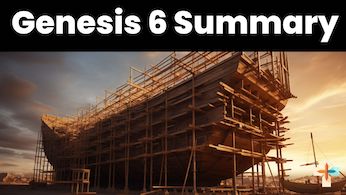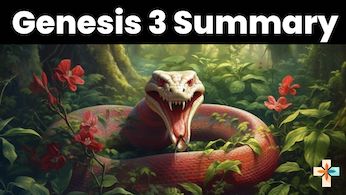Genesis 1 Summary Overview
Genesis 1 portrays the creation of the universe, detailing God’s establishment of order, life, and humanity’s unique role. This foundational chapter highlights God’s power, creativity, and the inherent goodness of creation, setting the stage for humanity’s relationship with the divine throughout Scripture.
Intro
Genesis 1, the opening chapter of the Bible, provides a majestic and detailed account of God’s creation of the universe. This foundational scripture sets the stage for the unfolding drama of God’s relationship with humanity throughout the rest of Scripture.
In this article, we will explore the events of Genesis 1 in depth, providing an impactful and insightful summary of Genesis 1 to help you understand this chapter.

Where are you on your Spiritual Journey? Discover where you are on your Spiritual Journey in just 60 seconds and find out your next steps.
Take Your Spiritual Journey QuizI. The Creation of the Heaven and the Earth (Genesis 1:1-2)
The chapter begins with a concise statement of God’s act of creation: “In the beginning, God created the heavens and the earth” (Genesis 1:1 ). This verse establishes that God is the Creator and source of all things, existing before and outside of creation. Verse 2 describes the initial state of the earth as “formless and empty,” signifying the potential for God to bring forth life and order out of chaos (Genesis 1:2 ).
II. The First Day: Light and Darkness (Genesis 1:3-5)
God’s first creative act is the separation of light from darkness (And God said, “Let there be light,” and there was light. And God saw that the light was good. And God separated the light from the darkness. Genesis 1:3-4 ). Light symbolizes knowledge, goodness, and the divine presence, while darkness represents the absence of these qualities. By distinguishing between light and darkness, God sets the stage for the establishment of order, time, and purpose. God called the light Day, and the darkness he called Night. And there was evening and there was morning, the first day Genesis 1:5. This is how God designates the first day of creation by calling the light “day” and the darkness “night”.
III. The Second Day: Separation of the Waters (Genesis 1:6-8)
On the second day, God creates an expanse, or firmament, to separate the waters above from the waters below (And God said, “Let there be an expanse in the midst of the waters, and let it separate the waters from the waters.” Genesis 1:6 ). This division establishes the heavens and the earth as distinct entities, with the firmament serving as a boundary between them. God calls the expanse “Heaven” and some translations use the word sky (And God called the expanse Heaven. And there was evening and there was morning, the second day. Genesis 1:8 ), further emphasizing the structure and order he is bringing to creation.
IV. The Third Day: Dry Land and Vegetation (Genesis 1:9-13)
On the third day, God gathers the waters under the sky into one place, allowing dry ground to appear (And God said, “Let the waters under the heavens be gathered together into one place, and let the dry land appear.” And it was so. Genesis 1:9 ). He calls the dry ground “land” and the gathered waters he calls “seas” in Genesis 1:10. This act highlights God’s power to shape and define the physical world. He then commands the land to produce vegetation, including seed-bearing plants and fruit trees (And God said, “Let the earth sprout vegetation, plants yielding seed, and fruit trees bearing fruit in which is their seed, each according to its kind, on the earth.” And it was so. Genesis 1:11 ). These plants provide sustenance and establish the cycle of growth and reproduction that will continue throughout creation (The earth brought forth vegetation, plants yielding seed according to their own kinds, and trees bearing fruit in which is their seed, each according to its kind. And God saw that it was good. Genesis 1:12 ). This day concludes with the familiar theme, marking the completion of the third day (And there was evening and there was morning, the third day. Genesis 1:13 ).
V. The Fourth Day: Sun, Moon, and Stars (Genesis 1:14-19)
On the fourth day, God creates the sun, moon, and stars to govern the day and night (And God said, “Let there be lights in the expanse of the heavens to separate the day from the night. And let them be for signs and for seasons, and for days and years, and let them be lights in the expanse of the heavens to give light upon the earth.” And it was so. Genesis 1:14-15 ). These celestial bodies or heavenly bodies not only provide light and mark the passage of time but also serve as signs for seasons, days, and years (Genesis 1:14 ). By setting these celestial bodies in motion, God establishes the rhythms and cycles of life that will shape the experiences of all living creatures (And God made the two great lights—the greater light to rule the day and the lesser light to rule the night—and the stars. And God set them in the expanse of the heavens to give light on the earth, to rule over the day and over the night, and to separate the light from the darkness. And God saw that it was good. And there was evening and there was morning, the fourth day. Genesis 1:16-19 ).
VI. The Fifth Day: Sea Creatures and Birds (Genesis 1:20-23)
On the fifth day, God fills the seas with living creatures and the skies with birds (And God said, “Let the waters swarm with swarms of living creatures, and let birds fly above the earth across the expanse of the heavens.” Genesis 1:20 ). These creatures embody the diversity and beauty of God’s creation, showcasing his creativity and power (So God created the great sea creatures and every living creature that moves, with which the waters swarm, according to their kinds, and every winged bird according to its kind. And God saw that it was good. Genesis 1:21 ). God blesses the sea creatures and birds, commanding them to be fruitful and multiply, ensuring the continuation of life in the waters and the skies (And God blessed them, saying, “Be fruitful and multiply and fill the waters in the seas, and let birds multiply on the earth.” And there was evening and there was morning, the fifth day. Genesis 1:22-23 ).
VII. The Sixth Day: Land Animals and Humanity (Genesis 1:24-31)
On the sixth day, God creates the land animals, each according to its kind (And God said, “Let the earth bring forth living creatures according to their kinds—livestock and creeping things and beasts of the earth according to their kinds.” And it was so. Genesis 1:24 ). These creatures further demonstrate the richness and complexity of God’s creation (And God made the beasts of the earth according to their kinds and the livestock according to their kinds, and everything that creeps on the ground according to its kind. And God saw that it was good. Genesis 1:25 ). Finally, God creates humanity in his own image (Then God said, “Let us make man in our image, after our likeness. And let them have dominion over the fish of the sea and over the birds of the heavens and over the livestock and over all the earth and over every creeping thing that creeps on the earth.” So God created man in his own image, in the image of God he created him; male and female he created them. Genesis 1:26-27 ). This act sets humans apart from the rest of creation, signifying our unique relationship with the Creator and our responsibility to care for the earth and its creatures.
God gives humanity dominion over the earth, the animals, and the plants, emphasizing our role as stewards of creation (And God blessed them. And God said to them, “Be fruitful and multiply and fill the earth and subdue it, and have dominion over the fish of the sea and over the birds of the heavens and over every living thing that moves on the earth.” Genesis 1:28 ). In bestowing this authority, God entrusts us with the responsibility to manage and care for his creation responsibly and sustainably. God sees that all he has made is “very good” (And God saw everything that he had made, and behold, it was very good. And there was evening and there was morning, the sixth day. Genesis 1:31 ), a clear affirmation of the inherent, natural goodness of creation and the potential for humanity to live in harmony with it.
VIII. A Time of Rest: The Seventh Day (Genesis 2:1-3)
Although this passage belongs to the second chapter of Genesis, it serves as a conclusion to the creation narrative. God completes his work of creation on the seventh day, and he rests (Thus the heavens and the earth were finished, and all the host of them. And on the seventh day God finished his work that he had done, and he rested on the seventh day from all his work that he had done. Genesis 2:1-2 ). This act of rest does not imply that God is weary or that he needed to recoup. Instead, it signifies the completion of his creative work and serves as a model for the observance of the Sabbath, a time of rest and reflection on the goodness of creation (So God blessed the seventh day and made it holy, because on it God rested from all his work that he had done in creation. Genesis 2:3 ).
Conclusion
Genesis 1 is a profound and foundational text that reveals the nature of God as Creator, the order and beauty of his creation, and the unique role of humanity within it. This chapter invites us to contemplate the purpose and meaning of our existence, challenging us to live responsibly and reverently as stewards of God’s creation. By understanding and appreciating the depth and richness of Genesis 1, we can better grasp the overall message of Scripture and our place in the unfolding story of God’s relationship with humanity.
Michael Ayers
As a dedicated single father, author, teacher, and web developer, I've built a successful entrepreneurial career. I'm responsible for designing, coding, writing, and producing all the content on this website and have generated over 1,000,000 plus page views on all the websites I manage. I hope you enjoy this site.
Where are you on your Spiritual Journey? Discover where you are on your Spiritual Journey in just 60 seconds and find out your next steps.
Take Your Spiritual Journey Quiz

